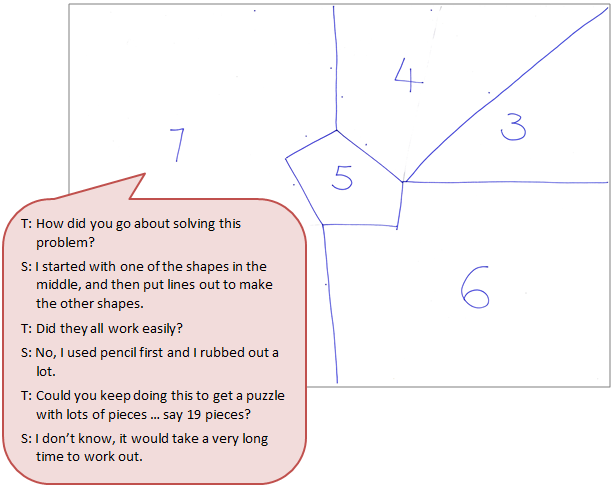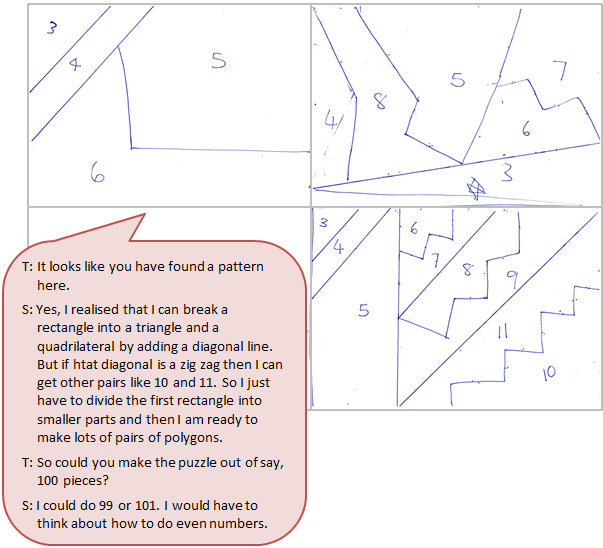The purpose of this activity is to engage students in using the properties of irregular polygons to solve a problem.
This activity assumes the students have experience in the following areas:
- Identifying the features and properties of polygons.
- Recognising the properties of regular polygons, including angles and sides.
- Connecting the properties of regular and irregular polygons to find similarities and differences.
The problem is sufficiently open ended to allow the students freedom of choice in their approach. It may be scaffolded with guidance that leads to a solution, and/or the students might be given the opportunity to solve the problem independently.
The example responses at the end of the resource give an indication of the kind of response to expect from students who approach the problem in particular ways.



A maths teacher wants to make a puzzle out of irregular polygons, one each from a triangle to a heptagon, that fit together to make an A4 sheet of card.
Can you design such a puzzle?
The following prompts illustrate how this activity can be structured around the phases of the Mathematics Investigation Cycle.
Make sense
Introduce the problem. Allow students time to read it and discuss in pairs or small groups.
- Do I understand the situation and the words? (Students may need support to understand the meaning of ‘irregular’ and to recognise polygons that are not in prototypical form. That includes concave polygons.)
- What are the important words? (The polygons are named by their prefixes. For example, ‘hexa’ means 6 and a hexagon has 6 sides. In ancient Greek “poly” means many and “gon” means angle.)
- What will my solution look like? (The solution will be a puzzle that has the n-gons from triangle to heptagon. There should be clear description of how the puzzle was created.)
- Do I know of puzzles I have seen that may be helpful in designing this one?
Plan approach
Discuss ideas about how to solve the problem. Emphasise that, in the planning phase, you want students to say how they would solve the problem, not to actually solve it.
- What strategy might I used to get started? Do I think I can solve the problem by trial and improvement or will I need to be more strategic?
- How am I recording my workings so I know how the problem was solved?
- What checks will I need to do to ensure my solution meets the requirements?
- Have I considered all the possible shapes for each polygon, so I don’t miss any opportunities?
- Could I start with an easier puzzle and learn from it?
- What patterns do I expect to see?
- What tools will help me? (Digital platforms like PowerPoint and Geogebra allow for experimenting with the design.
Take action
Allow students time to work through their strategy and find a solution to the problem.
- Are my workings clear?
- Can I be sure I haven’t missed anything?
- Is my strategy working? Should I try another way to solve the problem?
- How can we share the mahi in our group to get the best result?
- Do I see a pattern in the way the shapes fit together on the page?
- Does the pattern always work? Will it work if I need more polygons in the puzzle?
- What is the same and what is different about the designs of others?
Convince yourself and others
Allow students time to check their answers and then either have them pair share with other groups or ask for volunteers to share their solution with the class.
- What is the solution? Am I sure it matches the conditions?
- Is my working clear for someone else to follow?
- How would I convince someone else I am correct?
- Could I have solved the problem in another way?
- Will my strategy work for more complex puzzles?
- Which ideas did I use in my investigation?
- What could I try differently next time?
- What could I find out next?
Examples of work
Work sample 1
The student designs a puzzle by trial and improvement, that meets the criteria of each shape being irregular. They recognise a concave 7-sided polygon as a heptagon.
Click on the image to enlarge it. Click again to close.
Work sample 2
The student develops a design algorithm that allows them to create a puzzle for any odd number of irregular polygons.

